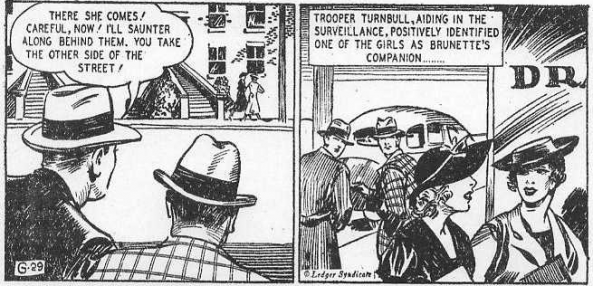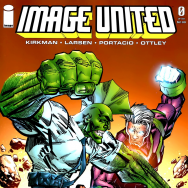Comics have been around for a long time and there is no shortage of fascinating stories in the history of the medium. This column looks back at select events that occurred during the calendar month from years long gone. Here are a few from a previous May.

Nearly 20 years before the US government targeted crime comics as a root cause of childhood troubles, FBI director J Edgar Hoover was a huge fan of them. In an interview with The New Yorker, he claimed to be subscribed to five newspapers mainly to follow the comic strips. His two favorites were “Dick Tracey” and “Secret Agent X-9,” both lone wolfs enforcing justice in romanticized adventures. Like many comic fans, Hoover gave serious thought to how his favorites could be even better. Unlike most comic fans, he was able to put his ideas into practice.
At Hoover’s “suggestion” (because who was going to tell that guy no?), Philadelphia’s Ledger Syndicate added the daily “War on Crime!” strip to its roster on May 18, 1936. It was based on real FBI files on the celebrity criminals from the prohibition era. Hoover handpicked crime reporter Rex Collier to write the strip based on his prior coverage of the Bureau. After Collier wrote the sequences with help from Frank Godwin and it was drawn by Kemp Sterrett, Hoover and his associate Clyde Tolson reviewed and approved every word and image. Predictably, the strip was boring. In addition to Collier’s wordy captions that were often redundant to the artwork, the strip quickly ran out of good material. By it’s tenth storyline, it had blown through all the criminals who were actually famous and began covering also-rans like Two-Gun Brunette. To make matters worse, Collier accurately depicted the FBI as a functional organization – that meant no lone wolf avenger, no super-successful team like on NCIS, not even recurring characters for the readers to root for. Despite its circulation peaking at 45 newspapers, readers everywhere pretty much ignored the strip. After about a year, Sterrett was replaced by Jimmy Thompson. Ostensibly cancelled for a lack of material, the final panels were run January 22, 1938. It was reprinted in “Famous Funnies” shortly thereafter, and then forgotten by nearly everyone.

In 1978, Marvel was updating its policies following some recent changes made to American copyright law. This came in the form of a multipage document passed down from their legal department full of legal jargon and was met with disdain from the freelancers who were asked to sign it. Editor-in-Chief Jim Shooter condensed it down to a single page of plain English (effectively: “You are work-for-hire and Marvel owns all rights to your work forever.”), but many creators still didn’t like it. Neal Adams told people not to sign it until it had been discussed, and he hosted a meeting at his studio on Sunday, May 7, 1978. There were at least 100 people there, and maybe as many as 300, including Shooter and DC’s EiC Paul Levitz.
In addition to discussing the contract, Adams used the opportunity to promote the Comic Book Creators Guild and the effort he was leading to unionize the industry. There were several points to his agenda, but the primary one was about pay. He felt everyone involved in comic creation needed a raise, along with an industry-wide minimum pay rate for various positions. The rates he put forward were based on what top creators had made in 1952, adjusted for inflation and other factors. It worked out to huge increases for everyone – pencilers would get 300-800% more per page, depending on their current rate and who you ask. This was an immediate non-starter, because Adams had been misinformed about an important fact: the industry was ailing. He had been provided figures and estimates that made him believe Marvel and DC were pulling down massive profits, but the reality was that Marvel was barely breaking even and management had serious concerns that its owner, Cadence Industries, would close it down and sell off the intellectual property and other assets like they’d down with other companies in the past. Adams and the Guild later claimed those rates were intended to make a point, not a start to negotiations, but it cast them as unrealistic radicals in the eyes of many.
Continued belowThe other agenda points were a mixed bag. Howard Chaykin was a vocal supporter of Guild-run arbitration for between freelancers and publishers, which probably could have been worked out. Adams wanted publishers to notify the Guild when they needed services so the Guild could supply a writer/penciler/inker/letterer/colorist of their choice. It’s hard to imagine why a publisher would ever agree to that. Some attendees thought Adams’ proposals favored pencilers over other creators, and some inkers walked out of the meeting when Adams said all original art should be returned to the penciler, who could share with the inker if they felt like it. Other attendees thought Adams’ success had left him out of touch with the reality of average freelancers. One point that most agreed on was fighting for restitution for older creators who had been treated unfairly by publishers. That is, they agreed until Adams specifically mentioned Steve Ditko, who was in the audience. Ditko, who had strong philosophical opinions, spoke up to say that he had known the terms of the deal when he agreed to them. He would not be anyone’s poster boy for mistreatment.
Later that year, DC had a shakeup that saw its output reduced by about 40% in three months. The Guild’s job pool helped direct some of them to other employment, but the day after the announcement there was a long line waiting outside the doors at Marvel’s offices. Most were ex-DC freelancers who were hoping to sign Shooter’s contract and secure work. Others were current Marvel freelancers who hadn’t signed the contract yet and were now hurrying to do so before their work was given to someone else.
The Comic Book Creators Guild filed as a New York Domestic Not-For-Profit Corporation on June 6, 1979, and its official membership peaked around 35. Of those official members, only Chris Claremont made a living exclusively through comic books. The sudden drop in demand for freelancers put a stop to any thoughts about unionizing at the time, and never came back with much force. That’s partly because most creators saw their benefits start to improve without collective bargaining, but Adams has also mused that freelancers are too used to working independently to organize effectively. The group is still listed as active in New York State.

In May 2008, all of the current Image Comics partners participated in a joint signing session at a Free Comic Book Day event. They were having a good time and someone mentioned how fun it would be to do something together. Fast forward to SDCC 2008 when they announced “Image United”, a six-issue miniseries with art by six of the seven original founders and scripting by Robert Kirkman, who had recently become a partner too. The series promised to bring together the characters created by the founders, and each character would be drawn by its creator. This would effectively make every page a jam piece, and pretty much every one was instantly skeptical of it staying on schedule. Image had always had a bad reputation for lateness, and these artists were single-handedly responsible for starting it. Nevertheless, everyone promised this would be on time because otherwise it would just be embarrassing – like that time their 10th anniversary project came out right before their 14th birthday. Plus, this miniseries promised to have big impacts on the ongoing series that fed into it.
To put the minds of readers and retailers at ease, an 11-page preview of the first issue was available at SDCC 2009, four months before the issue would be published. In October 2009, “Savage Dragon” #153, “Witchblade” #131, “Invincible” #67, and “Spawn” #197 each contained four pages of a sixteen page prelude that set up the first issue. Then, in November 2009, the first issue appeared right on time with a heap of variant covers. Reviews were pretty average, but it was a novelty and the consensus was that fans were getting exactly what they expected. The next month, issue two also appeared on schedule. Reviews were a little worse as the novelty wore off and the combined art failed to mesh well or tell a smooth story.
The third issue, due out in January 2010, didn’t show up until August. To fill in the gap, Kirkman whipped out a #0 issue with art by Eric Larson, Whilce Portacio, and Ryan Ottley. Rob Liefeld, who was understandably frustrated and embarrassed, blamed Todd McFarlane and Mark Silvestri for the delay. McFarlane publicly accepted all the blame for it, then worked to redeem himself by being the first one done with issue 4. In January 2011, Larson claimed in an interview that the fourth issue was about 60% done. In March 2011, he was doing layouts for the fifth issue. Another fill-in issue, “Image United: Interlude”, was announced but never released. Although the monthly books have long-since moved on (as have most readers), effort on the miniseries continues. Liefeld tweeted that he was working on pages for it in January 2019. If it’s ever completed, it’ll be fascinating to see what kind of sales it can muster.






